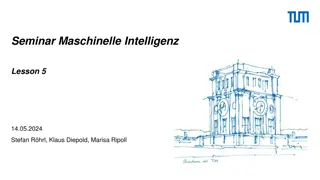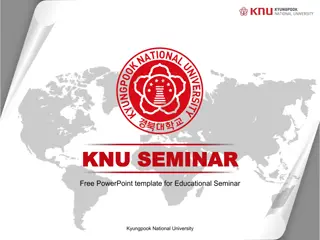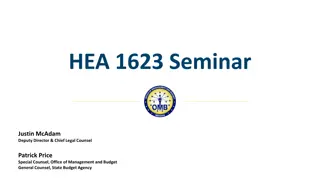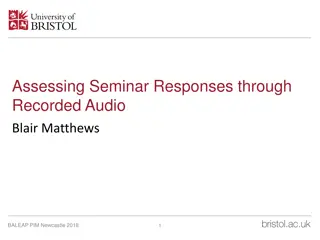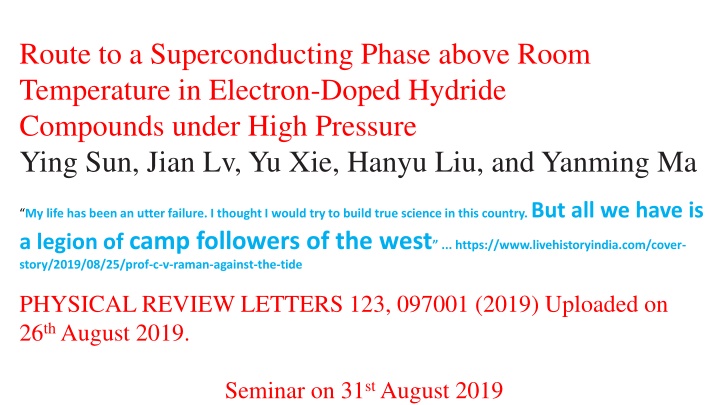
Exploring Superconducting Phase in High-Pressure Hydride Compounds
Discover the latest research on achieving a superconducting phase above room temperature in electron-doped hydride compounds under high pressure. The study delves into the potential of various hydride compounds, including their structures, transition temperatures, and implications for superconductivity. Find out how metal doping and ternary systems play a crucial role in the search for room-temperature superconductors.
Download Presentation

Please find below an Image/Link to download the presentation.
The content on the website is provided AS IS for your information and personal use only. It may not be sold, licensed, or shared on other websites without obtaining consent from the author. If you encounter any issues during the download, it is possible that the publisher has removed the file from their server.
You are allowed to download the files provided on this website for personal or commercial use, subject to the condition that they are used lawfully. All files are the property of their respective owners.
The content on the website is provided AS IS for your information and personal use only. It may not be sold, licensed, or shared on other websites without obtaining consent from the author.
E N D
Presentation Transcript
Route to a Superconducting Phase above Room Temperature in Electron-Doped Hydride Compounds under High Pressure Ying Sun, Jian Lv, Yu Xie, Hanyu Liu, and Yanming Ma My life has been an utter failure. I thought I would try to build true science in this country. But all we have is a legion of camp followers of the west ... https://www.livehistoryindia.com/cover- story/2019/08/25/prof-c-v-raman-against-the-tide PHYSICAL REVIEW LETTERS 123, 097001 (2019) Uploaded on 26th August 2019. Seminar on 31st August 2019
Th4H15 Tc 8 K at ambient pressure 1970 H rich metal hydrides may be responsible for SC 2004 Ashroft high pressure conditions can metallize hydrogen rich materials that are insulators at ambient pressure SH3 LaH10 ~200 ~250-260 K [2014-2019] SH2 turns SC at 100GPa Tc 30-150 200K BCS SH3 ~200K two interpenetrating perovskite lattice H is located symmetrically between each pair S atoms. This three dimensional network of covalently bonded H appears only in SH3 and SeH3
Theoretical studies predict in sodalike like clathrate LaH10 at ~280 K, 2Mbar Experimental Fm3m LaH10 Tc =260 K, 250 K at 190 and 170 Gpa Bond La-H ionic H atoms for clathrate like sodalite weakly covalent H-H~1.2A CaH6 and alkaline earth, rare earth hydrides H electron density at Fermi level Clatharate compounds are suitable for RT superconductivity MgH12, MgH16, YH24, AsH8 <150K
These hydrides contain a large amount of H2-like or H3-like (e.g., KH5 [26]) molecular units, in which the H electrons occupy the low-lying bonding orbits ( ) that are far from the Fermi level. Consequently, the electron densities of states at the Fermi level are low in these hydrides, even though the H content is higher. High-Tc superconductivity relies on intramolecular H-H bonds being broken to have H electrons in energy states near the Fermi level. To achieve this, extra electrons can be introduced via metal doping into the system, allowing the antibonding states of H2 or H3 molecules to accept electrons for dissociation of the molecules
Ternary hydrides BeReH9, Li5MoH11 , 10 K Crystal structure prediction simulations for ternary systems are computationally demanding. Theoretically studied ternary systems can be mainly classified as variants of the cubic SH3 structure and substitutional alloys of MH6 (M = Ca, Y) , and their Tc values are generally lower than those of LaH10 ( 280 K) and YH10 ( 303 K) . Searching for room-temperature or higher-temperature superconductors among the ternary hydrides remains a challenging but pressing task
Scope: designing high temperature superconductors through introducing extra electrons via metal doping into known hydrogen-rich binary systems that contain abundant H2 or H3 molecular like units
The role of the extra electrons is to break up the H molecules to make atomic hydrogen more abundant than the parent phase, which is necessary for stabilizing high-Tc structures. Use lithium-doped magnesium hydrides as the model system, because the parent MgH16 system contains a large amount of H2 molecules and Li has a similar atomic radius to Mg but a smaller electronegativity, allowing a larger charge transfer from Li to H.
The high-pressure ternary phase diagram of the Li-Mg- H system is constructed through extensive structure searching simulations via the swarm intelligence-based CALYPSO method. There is a nearly linear correlation between the number of electrons accepted per H2 unit and H-H separation, implying a trend on the creation of atomic H via metal doping in binary hydrides. The results also reveal a unique clathrate structure with a stoichiometry of Li2MgH16 and an unprecedented highest Tc of 473 K at 250 GPa
We examine the phase diagram of LixMgyHz at 300 Gpa [Figs. 1(a)] focusing on H-rich species. Although all ternary hydrides are thermodynamically stable against dissociation into pure elements, they are metastable phases with respect to decomposition into the energetically most favorable binary phases
This metastability does not preclude these materials from experimental synthesis. According to the inorganic crystal structure database, 20% of experimentally synthesized materials are metastable, some of which even have high positive formation enthalpies with high energy gains larger than 40 meV/atom. For Li2MgH16, it is also proposed a synthetic route through the chemical reaction of LiH, MgH2, and H2, where the calculated formation enthalpy is highly negative, at 84 meV/atom at 300 GPa.
The electronic properties of LixMgyHz based examined on crystal structure. Bader charge analysis reveals a large charge transfer from Li/Mg to H, suggesting that both Li and Mg are electron donors and bonding is ionic between H and Li/Mg atoms. To investigate the H-H bonding character, we calculate the integrated crystalline orbital Hamiltonian population (ICOHP) for H-H pairs to characterize the orbital interaction between two H atoms. For various ICOHP values, where stronger H-H bonds (shorter r H-H) give larger negative values. Fig. 1(b) shows a nearly linear correlation between the average Bader charges per H2 and the average rH-H of the strongest H-H bonds in the Li-Mg-H system at 300 GPa, which is consistent with previous reports. If the number of electrons accepted per H2 reaches 0.6e, the H2 molecule readily dissociates as the H-H bond length increases to about 1.0 , which is similar to the H-H distance (0.98 ) in monatomic solid hydrogen at 500 Gpa . This result is also supported by a direct comparison of the child structure of LixMgH16 ( x =1, 2, and 3) with its parent structure of MgH16 at 300 GPa , where the H-H distance increases with increasing Li content.
(a) Calculated stabilities of three-component LixMgyHz relative to Li , Mg , and H at 300 GPa. Colored squares denote metastable phases (above the convex hull, . Purple circles indicate stable phases [. Black lines between purple circles connect stable phases. (b) Variation of the H-H separation (rH-H) in a H2 molecule with the electrons accepted per H2 molecule in the Li-Mg-H system at 300 GPa
The stoichiometry of Li2MgH16 (with a space group of P3m1) has the lowest enthalpy, but is 20 meV/atom above the convex hull of the LixMgyHn compounds . The calculated enthalpies as a function of pressure are shown in Fig. 2(a). The most stable phase in the pressure range of 300 727 GPa is P 3m1, consisting of partially dissociated H2 units(0.83and0.98 ,at300GPa) . Above 727 GPa, an unusual clathrate structure [space group Fd 3m, Fig. 2(b)], which contains Li-centered H18 cages and Mg-centered H28 cages and no H2 units, becomes the ground state. Each H18 or H28 cage consists of 6 or 12 pentagons and 4 hexagons, with H-H bond lengths of 1.02, 1.08, and 1.20 , respectively, although the electron localization result indicates that the H-H bonds are covalent. Because of the high vibrational frequency arising from light elements, the zero-point motion is critical in determining the phase stabilities
Compared with the atomic H in the Fd 3m phase, the H2 molecular units in the P 3m1 phase produce higher frequency phonons. Thus, there is a large energy difference (30 meV=atom) between P 3m1 and Fd 3m structures, which is similar to that between molecular and atomic hydrogen at 500 GPa (29 meV/atom,. Consequently, the phase transition between P 3m1 and Fd 3m occurs at a substantially lower pressure of 453 GPa at 0 K . The absence of an imaginary frequency in the phonon spectra indicates that the clathrate structure is dynamically stable above 250 GPa . Moreover, the high temperature can help to stabilize the Fd 3m structure further if compared with P 3m1 , indicating that the Fd 3m phase may be realized at high temperature
All the predicted Li-Mg-H ternaries are metallic at 300 GPa, as confirmed by the electronic band structure calculations. In particular, Fd 3m-Li2 MgH16 has the highest H-dominated electronic density of states at the Fermi level (NEF) that is almost twice that of MgH16 at 300 GPa. Therefore, to investigate its superconductive properties further. The calculated electron phonon coupling parameter ( ) of Li 2MgH16 is as high as 3.35 . This value is higher than those of MgH16 and any other Li-Mg-H ternary compound
The bending modes of atomic H (2072 THz) contribute 50% of the total , and Mg (below 15 THz) and Li atoms (10 20 THz) contribute 40% and 10%, respectively. There is no high-frequency vibration, consistent with the absence of molecular H2 units in the structure. The highest phonon frequency (72 THz, 2400 cm 1) can also be compared with other systems containing atomic H, such as 2600 cm 1 in the I41=and phase of metallic hydrogen at 500GPa,and2300 cm 1 in the Fm 3m-LaH10 phase at 300 GPa. The Eliashberg equation gives a better description of systems with strong electron-phonon coupling for > 1.5. The Tc values are evaluated through the direct numerical solution of the Eliashberg equation. Clathrate structured Li2MgH16 is predicted to be a potential room temperature superconductor with an estimated Tc value of up to 351 K with a typical Coulomb pseudopotential parameter = 0.1 at 300 GPa . Under the same conditions, the calculated Tc value is much smaller at 73 K for MgH16 due to the existence of the high content of H2 units. In particular, Fd 3m-Li2MgH16 is dynamically stable down to 250 GPa. NEf decreases upon decompression, whereas increases . The Tc value of Fd 3m-Li2MgH16 at 250 GPa is predicted to be even higher at around430 473K,with in the range of 0.16 to 0.1
As part of efforts to develop electron-doped superhydrides, we design a potential room- temperature ternary superconductor of Fd 3m-Li2MgH16, although the predicted synthetic pressure ( 250 GPa) is high. We note that this is the first ternary example of using our method, and we expect that investigations of other ternary systems may identify other high- temperature superconductors at pressures much lower than the current one. It is known that anharmonicity is important in the calculation of the Tc in many compressed hydrides . However, simulations with anharmonic effects are not performed since they are computationally demanding and will not fundamentally revise the high superconductivity of the Fd 3m structure.




